When it comes to the size of HR teams within modern organisations, is there a golden ratio? A one-size-fits-all approach? What factors should companies consider when evaluating HR’s impact on your business? How are HR responsibilities delegated across your organisation? What’s the capacity and resources of team members responsible for HR, and how does your company leverage data and technology to support HR functions? Does it invest in any people tech in the first place?
To find answers and gain more clarity into HR operating models, we joined forces with CIPD to conduct a study that surveyed 1,305 HR respondents and 814 non-HR senior managers based in the UK from organisations around the world of 50 employees or more.
<<Download the CIPD-HiBob report on how HR pros leverage HR tech and people data>>
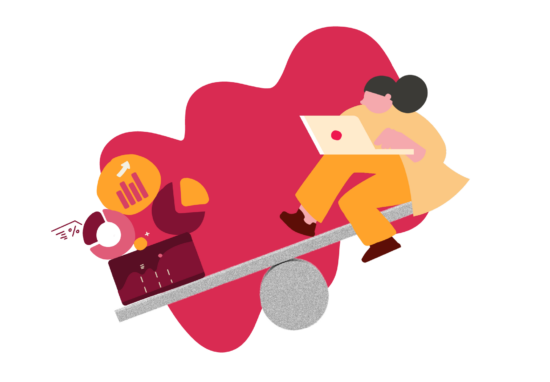
What functions fall under HR’s responsibility?
Respondents cited recruitment (84.2%) and HR systems (81.9%) the most when asked what their HR department oversees (Figure 1). Other top responses included reward and recognition (67.5%), inclusion and diversity (68.7%), performance management (65.0%), employee engagement and company culture (65.6%), learning and development (64.7%), and onboarding (64.2%).
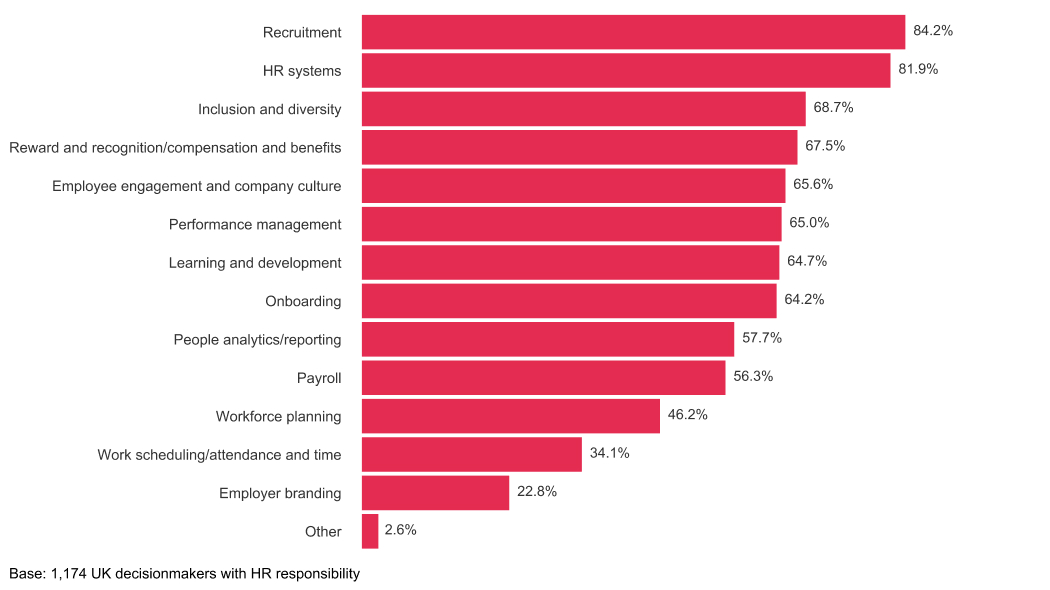
Our research shows that other than in the manufacturing sector (57.7%), work scheduling and time and attendance currently sit at the bottom of HR’s priorities (34.1%). Other low priorities include employer branding, global mobility, employee relations, and internal communications and events.
It’s important to note that several activities listed in the survey may have received lower priority because they are not managed by the HR department in every organisation. For example, payroll may fall under the responsibility of the Finance department rather than HR.
Other activities, like performance management, may fall under the purview of line managers. Additionally, certain activities may have received lower rankings because some respondents may be unaware of their HR department’s full scope of responsibility.
What HR software do organisations use for HR tasks?
For the purposes of this report, “HR software” refers to any software, tech, or platform a business uses to perform HR tasks and functions. To clarify, “software” can include any program accessed through a web app or browser or installed on company computers.
We asked respondents to the survey who identified as HR bosses to tell us about the specific types of HR software and platforms their organisation uses. Very few respondents reported that they didn’t know if their organisation uses specific HR software (6% or less), including reward and recognition software (9.5%), workforce planning software (12.8%), and people analytics (11.8%).
The majority said they used an HRIS (84.5%) and payroll software (82.9%). Respondents who reported that their organisation did not use HR software worked for companies with a global workforce of 550 people (78.7%) or fewer (70%).
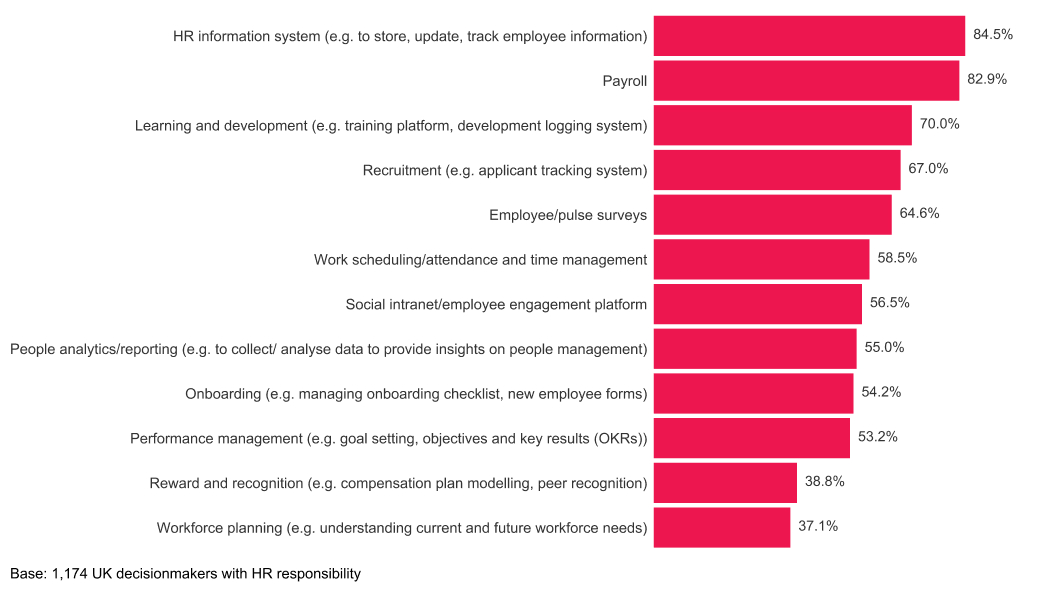
Reward and recognition software and platforms (for example, compensation plan modeling, peer recognition, etc.) came out on the lower end, with only 38.8% of HR bosses reporting that their organisations used them.
Despite workforce planning being particularly challenging to do, especially at scale, without the tech to provide and parse accurate data, respondents reported low usage of workforce planning software and platforms (37.1%).
Interestingly, another CIPD study found that 46% of people professionals reported that their organisations don’t collect data on critical areas, including:
- Talent availability
- Skills requirements for future needs
- Skill gaps within the organisation and industry sector
While HR bosses cited recruitment as the most overseen activity by HR departments (84.2%), as shown in Figure 1, only 67% reported that their organisations leveraged recruitment software (Figure 2).
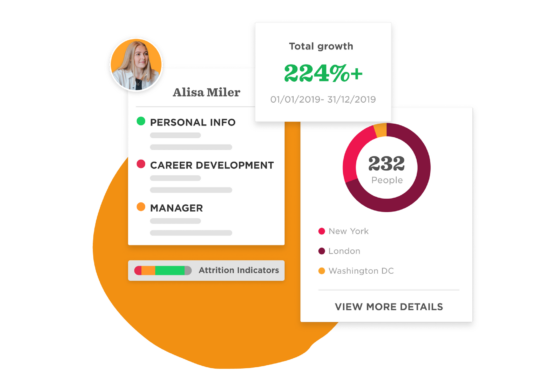
What workforce metrics does HR report to management?
This research found that the three metrics HR bosses report most to management on an annual or monthly basis are absenteeism rates (net 73.3%), employee turnover or retention (74.4%), and employee headcount change (75.1%).
Other critical metrics such as career path ratio, quality or cost of hire, and employee commitment may be more difficult to quantify and were reported to management at much lower rates (see Figure 3).
Top-tier, modern HRIS/HCMs can help support efforts to easily collect data on these metrics and ascribe meaningful definitions to each of them. For instance, the career path ratio metric reflects the number of internal promotions versus the number of all internal movements (lateral moves and promotions) employees have received across an organisation.
A modern HRIS/HCM automatically records role changes, therefore making it easy to track people’s career growth and calculate the company’s career path ratio. Companies equipped with this information can use it to craft data-driven employee retention and engagement strategies.
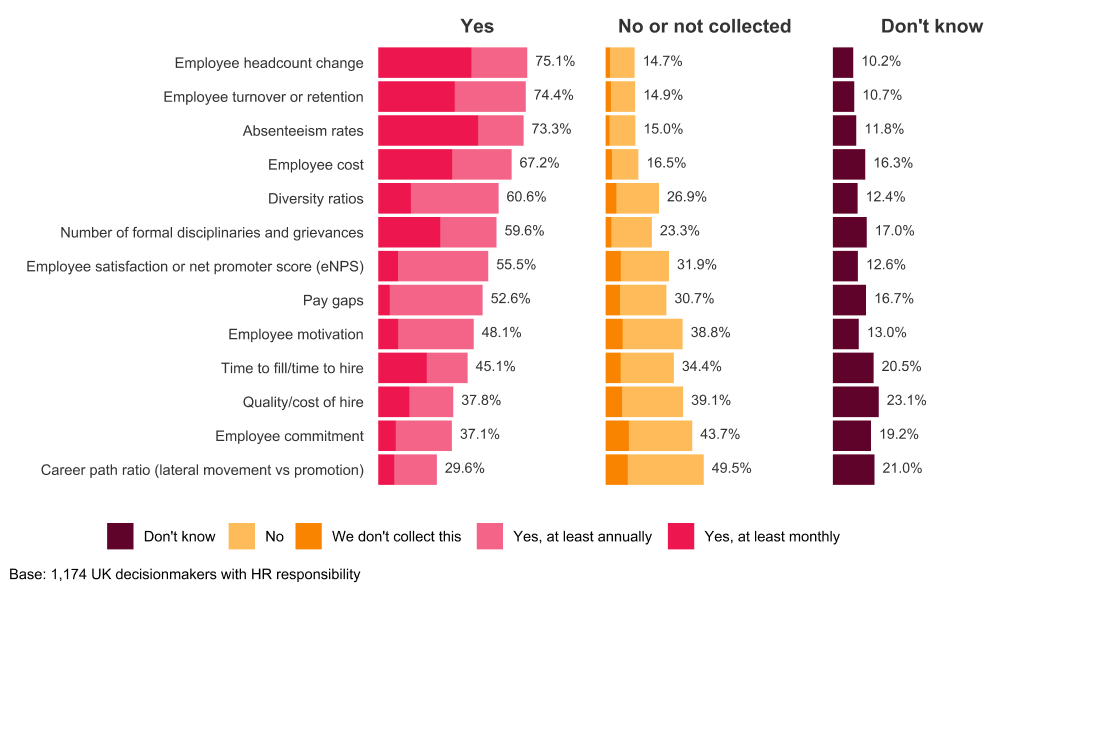
Although this data is critical, a significant percentage of HR bosses (between 10-21%), including those who had no knowledge of any reporting of workforce metrics, did not know if certain workforce metrics were regularly reported to management.
The research suggests that organisations that already used people analytics software were more likely to report workforce metrics to management. Figure 4 shows that organisations with people analytics software were much more likely to provide reports on workforce metrics than companies that do not have the software or that are not aware of the software (compare dark purple bars to light purple bars).
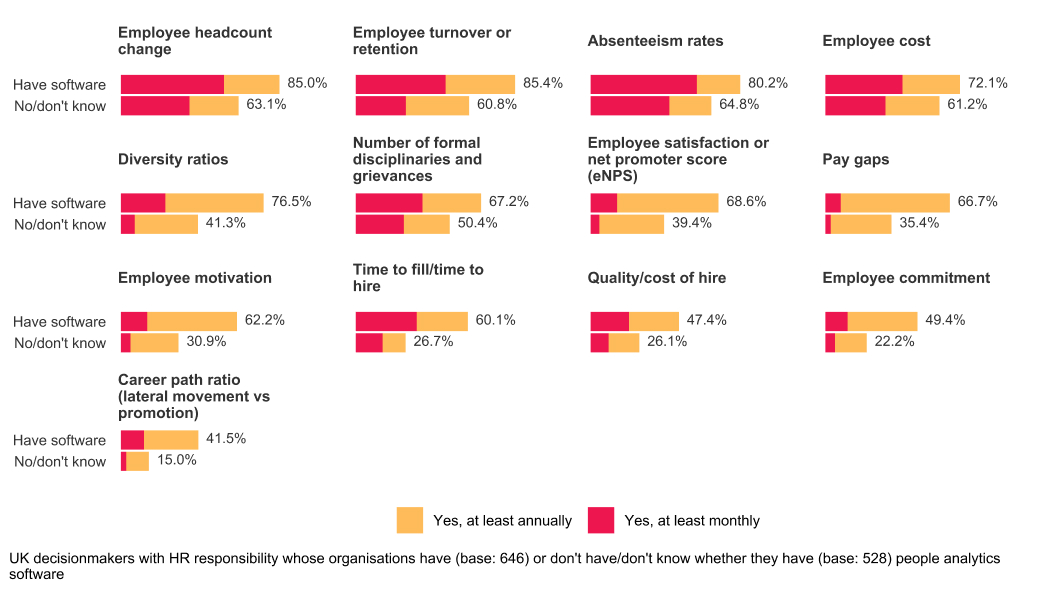
expands the scope of data they can draw on to make well-informed business decisions. Furthermore, modern HRIS/HCMs usually include self-service people analytics features that provide organisations with greater control over their data: Admins can set permissions that limit which individuals have access to specific data sets, including relevant key performance indicators (KPIs) and other query subsets.
Recommended For Further Reading
What is the typical HR-to-employee ratio?
Many survey respondents did not know how many HR professionals their company employed. Therefore, only 664 of the 1,174 responses included in the results contained valid estimates of the global HR-to-employee ratio. Of the 664 valid responses, the median HR-to-employee ratio came out to be 1:60.
The HR-to-employee ratio for the middle 90% of respondents ranged from 1:17 to 1:255. While Table 1 displays a wide range of ratios, it is uncommon for companies to have one HR team member for over 255 employees.
| Percentile | Global HR-to-employee ratio |
| 5th percentile | 1:17 |
| 10th percentile | 1:24 |
| 25th percentile | 1:37 |
| 50th percentile | 1:60 |
| Mean | 1:111 |
| 75th percentile | 1:100 |
| 90th percentile | 1:200 |
| 95th percentile | 1:255 |
HR-to-employee ratios may be interesting, but they don’t paint a clear and accurate picture of how companies worldwide value their HR organisations. Ultimately, the optimal HR-to-employee ratio depends on each organisation’s specific needs. While HR departments’ responsibilities can span a range of activities, this research shows that recruitment is the most common function of HR (Figure 1).

The bottom line: HR tech boosts business efficiency
Using a modern HRIS/HCM and leveraging quality people analytics helps increase the workforce metrics companies can rely on for critical insights and reporting. It also helps increase the reporting frequency and supports accurate and timely decision-making.
As your business grows, the responsibilities and workload will grow with it. Investing in modern HR tech is the key to streamlining your processes, increasing efficiency, and keeping your people happy—wherever they are in the world.
<<Download the CIPD-HiBob report on how HR pros leverage HR tech and people data>>
